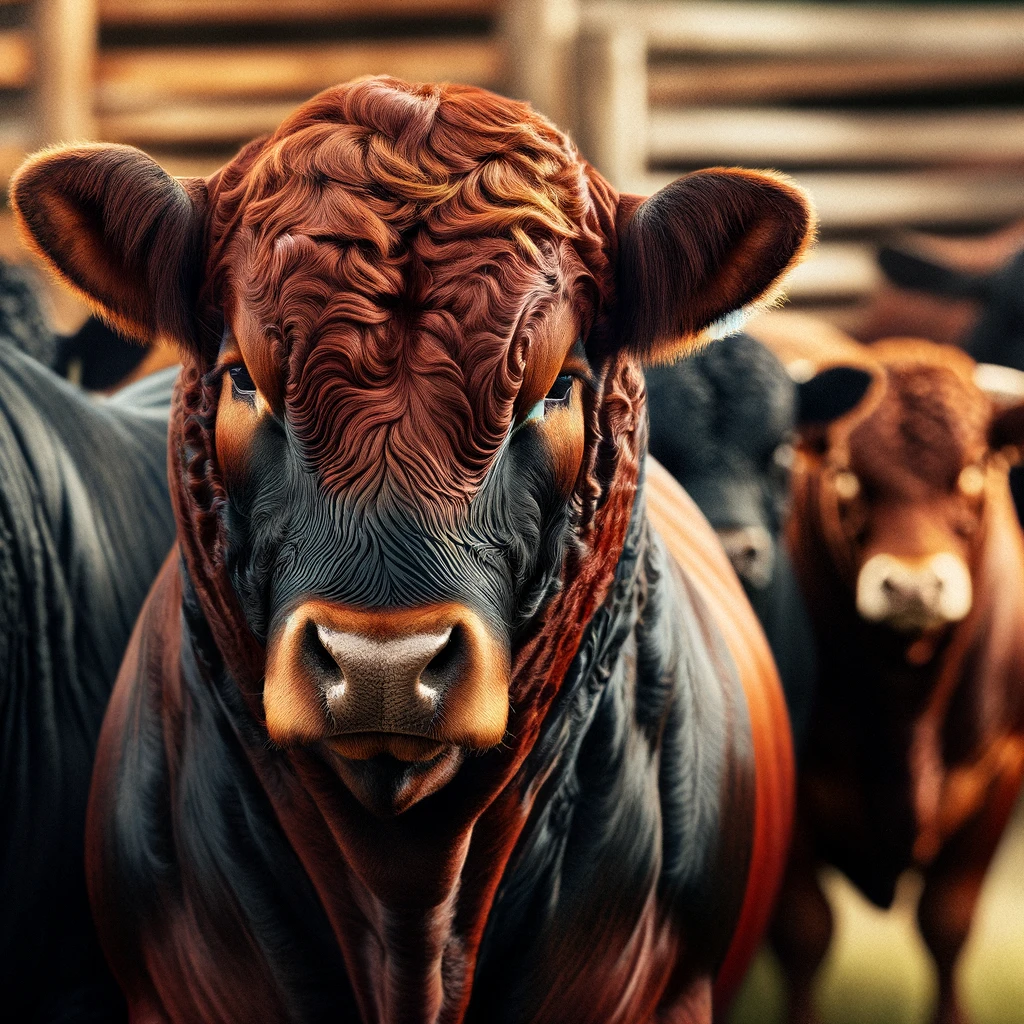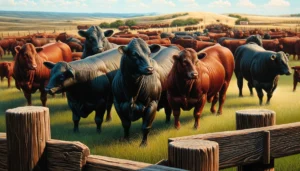Introduction to Raising Brangus Cattle
Brangus cattle, a hybrid breed developed by crossbreeding Brahman and Angus cattle, have gained popularity among ranchers for their adaptability, resilience, and quality beef production. This guide will provide comprehensive information on raising Brangus cattle, including their unique characteristics, benefits, and the essential practices for successful farming. Additionally, we will discuss the need for a Brangus Cattle Directory to connect breeders, buyers, and industry professionals.
Understanding Brangus Cattle
Origin and Development
Brangus cattle were developed in the United States in the early 20th century to combine the desirable traits of Brahman and Angus breeds. The resulting hybrid offers the heat tolerance and disease resistance of Brahman cattle and the superior meat quality and early maturity of Angus cattle. The Brangus breed is typically composed of 3/8 Brahman and 5/8 Angus genetics.
Physical Characteristics
Brangus cattle are medium to large in size, with a sleek, black or red coat. They exhibit the following physical characteristics:
- Heat Tolerance: Thanks to their Brahman heritage, Brangus cattle can withstand high temperatures and humidity, making them well-suited for warm climates.
- Disease Resistance: Brangus cattle have a strong immune system, providing resistance to common cattle diseases and parasites.
- Meat Quality: The Angus genetics contribute to high-quality beef with excellent marbling, tenderness, and flavor.
- Reproductive Efficiency: Brangus cows are known for their fertility, ease of calving, and strong maternal instincts.
Behavioral Traits
Brangus cattle are generally docile and easy to handle. They exhibit good mothering abilities, which contributes to high calf survival rates. Their adaptability to various environmental conditions makes them an excellent choice for diverse farming operations.
Benefits of Raising Brangus Cattle
Raising Brangus cattle offers numerous benefits, making them a popular choice among cattle farmers. Here are some key advantages:
Adaptability
Brangus cattle are highly adaptable to different climates and environments. Their ability to thrive in both hot and cold conditions allows farmers to raise them in various regions without significant challenges.
High-Quality Beef
The Angus genetics in Brangus cattle contribute to superior beef quality. The meat is well-marbled, tender, and flavorful, making it highly desirable in the market. This ensures a good return on investment for farmers.
Disease Resistance
Brangus cattle inherit disease resistance from their Brahman lineage, reducing the need for extensive medical interventions and lowering overall healthcare costs.
Fertility and Reproductive Efficiency
Brangus cows are known for their high fertility rates, ease of calving, and excellent maternal instincts. This results in higher calf survival rates and increased productivity.
Low Maintenance
Brangus cattle require less intensive management compared to other breeds. Their hardiness and ability to forage efficiently make them a low-maintenance option for farmers.
Setting Up Your Brangus Cattle Operation
Selecting the Right Stock
Choosing the right cattle is crucial for a successful Brangus operation. Consider the following factors when selecting your stock:
- Genetic Quality: Look for cattle with strong Brahman and Angus genetics. Verify pedigree records to ensure quality lineage.
- Health Status: Purchase cattle from reputable breeders with a history of disease-free herds. Conduct health checks to prevent introducing diseases to your farm.
- Physical Condition: Select cattle with good conformation, appropriate body condition, and no signs of illness or injury.
Housing and Fencing
Proper housing and fencing are essential for the well-being of your Brangus cattle. Here are some key considerations:
- Shelter: Provide adequate shelter to protect cattle from extreme weather conditions. This could be in the form of barns, sheds, or natural windbreaks.
- Bedding: Use clean, dry bedding to keep the cattle comfortable and prevent health issues related to damp environments.
- Fencing: Ensure secure fencing to contain your cattle and protect them from predators. Electric fencing can be effective for keeping cattle within designated areas.
Nutrition and Feeding
A balanced diet is crucial for the health and productivity of Brangus cattle. Here are some nutritional guidelines:
- Forage: Provide high-quality pasture or hay as the primary source of nutrition. Ensure a mix of grasses and legumes for optimal dietary balance.
- Supplementation: Depending on forage quality, supplement the diet with grains, minerals, and vitamins to meet nutritional requirements.
- Water: Ensure access to clean, fresh water at all times. Water is essential for digestion, milk production, and overall health.
Health Management
Maintaining the health of your Brangus cattle is vital for a successful operation. Implement the following health management practices:
- Vaccination: Follow a vaccination schedule to protect cattle from common diseases such as bovine respiratory disease, blackleg, and brucellosis.
- Parasite Control: Implement a parasite control program to manage internal and external parasites. This may include deworming, fly control, and regular monitoring.
- Routine Health Checks: Conduct regular health checks to monitor the condition of your cattle. Look for signs of illness, injury, or nutritional deficiencies.
- Veterinary Care: Establish a relationship with a local veterinarian who can provide routine care, emergency services, and expert advice.
Breeding and Calving
Efficient breeding and calving practices are essential for maintaining a productive herd. Here’s how to manage breeding and calving:
- Breeding Season: Determine the optimal breeding season for your operation based on your location and market demands. Typically, spring and fall are popular breeding seasons.
- Bull Selection: Select high-quality bulls with desirable traits to improve the genetic quality of your herd. Consider traits such as growth rate, carcass quality, and fertility.
- Calving Management: Monitor cows closely during calving season to ensure a safe and successful birth. Provide assistance if necessary and ensure a clean, dry environment for newborn calves.
- Weaning: Wean calves at an appropriate age (typically 6-8 months) to allow cows to recover and prepare for the next breeding season.

Marketing and Selling Brangus Cattle
Successful marketing and selling strategies are crucial for maximizing profits from your Brangus cattle operation. Here are some tips:
Identify Your Market
Determine your target market based on your location, production scale, and market demand. Common markets for Brangus cattle include:
- Breeding Stock: Sell high-quality breeding bulls and heifers to other cattle farmers.
- Commercial Beef Production: Sell weaned calves or yearlings to feedlots or processors for beef production.
- Direct-to-Consumer Sales: Sell beef directly to consumers through farmers’ markets, online platforms, or farm stores.
Build a Brand
Establish a strong brand identity for your Brangus operation. Highlight the quality of your cattle, sustainable farming practices, and commitment to animal welfare. Use branding to differentiate your products in the market.
Marketing Channels
Utilize various marketing channels to reach potential buyers:
- Online Presence: Create a professional website and social media profiles to showcase your operation, share updates, and engage with customers.
- Farm Tours: Offer farm tours to potential buyers and consumers to build trust and demonstrate the quality of your operation.
- Networking: Attend industry events, cattle shows, and agricultural fairs to connect with other farmers, buyers, and industry professionals.
Pricing Strategy
Set competitive prices based on market trends, production costs, and the quality of your cattle. Consider offering volume discounts or special deals for repeat customers.
The Need for a Brangus Cattle Directory
As the demand for Brangus cattle continues to grow, the need for a centralized directory becomes increasingly important. A Brangus Cattle Directory can provide numerous benefits for breeders, buyers, and industry professionals:
Connecting Breeders and Buyers
A comprehensive directory can connect breeders with potential buyers, facilitating the sale of high-quality Brangus cattle. It can provide detailed information on available stock, including pedigree, health status, and genetic traits.
Promoting Best Practices
The directory can serve as a platform for sharing best practices, success stories, and expert advice on raising Brangus cattle. This can help new and experienced farmers improve their operations and achieve better results.
Enhancing Genetic Diversity
By listing a wide range of breeders, the directory can promote genetic diversity within the Brangus breed. This can lead to healthier, more resilient cattle and improved overall herd quality.
Supporting Market Expansion
A Brangus Cattle Directory can help expand the market for Brangus cattle by increasing visibility and accessibility. This can lead to higher demand and better prices for breeders.
Facilitating Research and Development
The directory can also support research and development efforts by providing a centralized source of data on Brangus cattle. This can help researchers study breed characteristics, health trends, and genetic improvements.
Building a Community
A Brangus Cattle Directory can foster a sense of community among breeders, farmers, and industry professionals. It can provide a platform for networking, collaboration, and support.
Conclusion
Raising Brangus cattle offers numerous benefits, from high-quality beef production to adaptability and disease resistance. By implementing best practices in breeding, nutrition, health management, and marketing, farmers can successfully raise and sell Brangus cattle. Additionally, the establishment of a Brangus Cattle Directory can provide valuable resources, connections, and support for the Brangus community. Whether you’re a seasoned rancher or new to cattle farming, embracing the opportunities offered by Brangus cattle can lead to a rewarding and profitable venture.
For more detailed information and resources, visit the following links:
Embark on your journey with Brangus cattle today and discover the many benefits and opportunities this resilient and productive breed has to offer.


